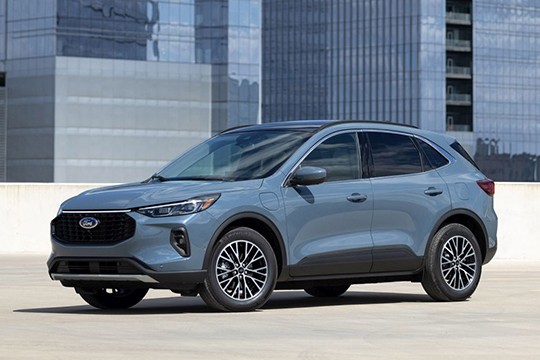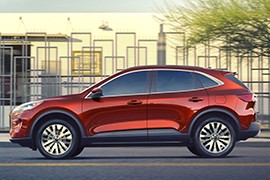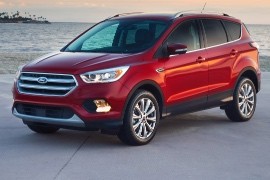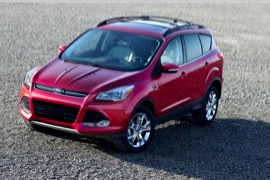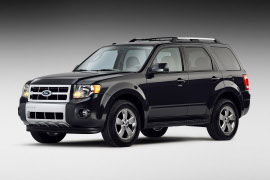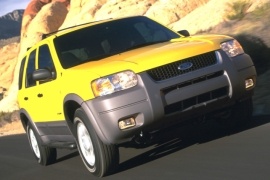FORD Escape Models/Series Timeline, Specifications & Photos
First production year: 2000
Engines: Plug-in hybrid, Gasoline, Hybrid, Diesel, Hybrid gasoline
Body style: SUV (Sports Utility Vehicle)
Ford refreshed the fourth generation of the Escape in 2022 for the 2023 model year and improved the car's look, the interior, and most importantly, the drivetrain.
Sharing its platform with the European Ford Kuga or with the Focus' fourth generation, the Escape proved to be a good bet for those looking for a crossover perfectly suitable for the urban environment. Moreover, it managed to be a good companion on long runs, albeit its rather short wheelbase didn't recommend it for cross-continental drives.
Moving to the facelifted version, the Escape offered a redesigned front fascia that featured narrower headlights with angular LED daytime running lights inside. Unlike its predecessor, the 2023 model featured a higher-mounted grille with a wide hexagonal shape and had the blue-oval badge mounted on it instead of on the upper side of the bumper. From its profile, the 2023 Escape didn't change too much, save for the front bumper. Finally, the rear side of the crossover sported redesigned taillights.
Inside, the most significant difference was on the dashboard, which received a new infotainment unit placed atop the center stack. It featured SYNC 4 technology that allowed a cloud-connected navigation system. In addition, it had wireless Apple CarPlay and Android auto smart driving capability.
Ford offered the Escape as a gasoline-only version, a hybrid, or a plug-in hybrid version.
Ford Escape was the pioneer of the hybrid SUV back in 2005 and with the new generation it intends to go further with the engineering, performance and ecology improvements. The promise is, also, that this third generation is more fun to drive than ever.
Under the hood Ford installed new units in compliance with the strictest, newest regulations but also with good performance. It starts with the 1.5-liter EcoBoost engine installed on the S, SE and SEL trims. This little unit will be good for 180 HP and 177 lb-ft of torque. Even though it is a small displacement engine, it will have a cylinder deactivation system. Sportiest version will host a 2.0-liter EcoBoost engine and will produce 250 HP and 275 lb-ft of torque.
Since it was launched as an eco-friendly SUV, the new Escape offers a new and innovative generation of hybrid propulsion system based on a 2.5-liter Atkinson cycle engine coupled with a CVT. This version will be FWD-only and will have 198 HP and a maximum 85 mph (137 kph) top speed only with the electric motor. Also, the Escape will be offered as an plug-in hybrid with a 30 miles electric-only range.
The new Escape is equipped as standard with an on-board 4G LTE Wi-Fi modem for up to 10 mobile devices. FordPass Connect gives drivers remote access to the vehicle with the help of their mobile phones.
Ford introduced the third generation of the Escape nameplate on the American market in 2011 at the Los Angeles Auto Show, and, in 2016, it improved it.
While the previous two generations were developed together with Mazda, the third iteration of the Escape nameplate had nothing to do with the Japanese carmaker. Actually, it was a rebadged European Ford Kuga, built on top of a Ford C1 Platform shared with the Focus and other Volvo/Mazda products.
For the facelifted version, Ford went all in and completely changed the front fascia. The 2016 model featured the chromed three-slat grille with a hexagonal shape. Also, the lower bumper received new fog lights in the side clusters mounted above the daytime running lights. At the back, there was a new tailgate and a redesigned set of taillights.
Inside, at first sight, it was a game of "spot the difference" challenge. The dashboard looked the same, albeit there was a new steering wheel and a revolutionary infotainment system named Sync3. The Escape was the first to receive this equipment that allowed users to connect to their cars via an app on their smartphones. They could unlock it, start the engine, and check the vehicle's status. Moreover, they could find it easier in a parking lot.
Under the hood, Ford introduced two new turbocharged engines that offered 179 hp and 245 hp, respectively. Besides these, there was also a 2.5-liter inline-four that Ford offered for the lowest-priced Escape.
The third generation of the Escape was a big departure from its previous model. It was a global car since it had the same shape in Europe, but with a different name. It was also known as the Kuga.
While the first generation of the Escape was like a pile of boxes on top of each other, the second generation featured a sleek design, with long and curved lines. The car was a true small cross-over with a footprint similar to a Ford Focus.
The car was designed in Europe, but it was successful in the U.S. as well. The front fascia featured angled headlights and an aerodynamically enhanced front bumper. The car was 10 percent more aerodynamic than the previous generation. Unlike the other two older versions, which were made together with Mazda, the 2017 model was 100% Ford.
Inside, the new generation of the MyFord Touch was installed. It featured a color screen on top of the center stack and the control buttons were right in front of it. As an option, a Sony premium sound system was on the list. The front seats offered good comfort and some side support due to its bolsters. In the back, there was room for three adults.
Unlike its European brother, it wasn't fitted with diesel engines. It didn't feature a V6 or a hybrid version as the second generation of the Escape. But it was fitted with the latest EcoBoost 1.6-liter engine, which was more fuel-efficient than the hybrid and a 2.0-liter EcoBoost that was more powerful than the V6. The base model featured a 2.5-liter inline-four. All versions were mated to a 6-speed automatic transmission. The automatic all-wheel-drive system transferred the torque from front to rear and from left to right wheels, according to the traction level.
The second generation of the Escape was released in 2008 and was kept in production until 2012.
The muscular SUV got a refreshed design, with a new grille that was similar to the Ford Expedition and the Explorer, only shrunken.
It was the same old platform and the same drivetrains, but had a much cleaner and modern look.
The modernised headlights, the chrome grille, the integrated fog lights and the Escape letters embossed across the bumper made the Escape attract the views of the customers.
From the side, the Explorer was pretty much the 1st generation SUV, with a clearer design. On the top we could see side rails, and side rails are always a good option, because if you later decide to mount them, it’s gonna be a hassle.
In the Back, the Explorer had updated taillights integrated in a clean simple design.
Inside the cabin of the Explorer we found a clean basic layout with improved material quality. Overall, it had a square look to match the outside design.
The Explorer was offered with 3 trim levels, the base XLS, the XLT, the top of the line, a hybrid and a limited hybrid. Lots of options we would say.
The SUV was equipped with power windows, power mirrors, power driver seat, leather seating surfaces (XLT), cruise control, a small lcd with compass, temperature and other audio information, climate control, air conditioning and a bluetooth connection.
The second generation of the Escape was unveiled at the 2007 Los Angeles Auto Show when the dark clouds of the world financial crisis were already in sight.
Ford already knew that a crisis was coming, but it launched the vehicle instead of waiting to see what would happen. Fortunately for the American automaker, it built the Escape's second generation on top of the same CD2 platform as its predecessor, thus lowering development costs. In addition, that was jointly developed with Mazda, which led to lower production costs. Moreover, customers had already switched their focus towards SUVs instead of station wagons and MPVs.
With a similar shape as its predecessor, the 2008 Escape featured a front fascia with large headlights that resembled those installed on the successful F-150, with a deeper inner side and smaller, corner-mounted blinkers. Moreover, the chromed grill with three vertical plus one horizontal bars tried to induce the idea of a serious off-roader, even though it wasn't a hard-core, go-anywhere truck. Despite having shaved corners, the Escape didn't look like it was meant to live only on asphalt. Finally, at the back, the taillights cut a small portion from the tailgate's mid-section, thus allowing it to provide a wide opening.
Inside, the truck-like dashboard was almost vertical, while the instrument cluster looked more car-related. Furthermore, on the center stack, Ford offered a sat-nav system. All trim levels received power windows and locks, electrically adjustable mirrors, and, for the driver's comfort, speed-sensitive electronic power-assisted steering, which was a first for the blue-oval brand.
Under the hood, Ford installed a range of gasoline engines paired with either a five-speed manual or a four-speed automatic. In addition, the carmaker offered a hybrid version as well.
The Ford Escape is a compact crossover and the original model was one of America's favorites. Released and developed with Mazda – it's almost the same as car as the Mazda Tribute.
Even if it is a compact SUV, it had the abilities of a larger one, yet it was easier to maneuver and park. The mid-sized model had enough room for 5 people to feel comfortable. The maximum towing capacity for an Escape with a towing package was around 1600kg.
The car is based on a unibody platform and came in two trim levels, XLS and XLT and was available with 2WD or AWD. The car is equipped with a four-wheel-lock system. Under the hood of the Escape we find a 3.0-liter V6 Duratec engine developing 200 hp, which would accelerate the car from 0 to 100 kph (62 mph) in a little over 10 seconds. It comes with an 4-speed automatic transmission, but gears can also be shifted manually.
Another option was a 2.0-L Zetec engine that could produce 130 hp and was more convenient due to its reduced fuel consumption compared to the 3.0-liter.
Some might say that the model was thirsty when it comes to fuel consumption, reaching 14-16L/100 km in regular use. The car was equipped with good safety features including seat-belts pre-tensioners and knee bolsters. All models had dual front airbags and the Limited trim level also had side airbags. The early XLS models did not have ABS.
